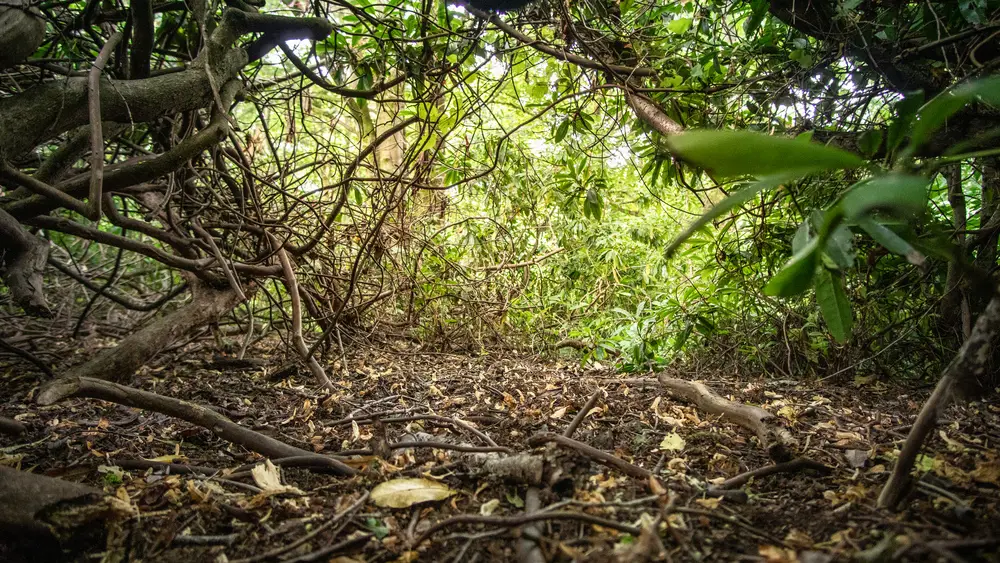How Scotland’s foresters are battling non-native invasive species
Invasive alien species are one of the main direct drivers of biodiversity loss worldwide. We’re making significant efforts to control invasive species across Scotland's national forests and land.
As part of this, we’re tackling invasive plant species like Rhododendron ponticum, salal (Gaultheria shallon), and American skunk cabbage (Lysichiton americanus).
We also support the efforts of other organisations to control species such as the North American signal crayfish; the American mink, which is a serious threat to native water vole; and the grey squirrel, which threatens the UK's native reds.

Rhododendron ponticum
Perhaps the best-known non-native invasive plant is Rhododendron ponticum (referred to simply as "rhododendron" for the rest of this blog), which reduces the biodiversity value and quality of soils it grows in.
Famously difficult to get rid of, it’s toxic to many species and research has shown it reduces the number of earthworms in the soil. It also physically reduces the presence of native ground flora and interrupts the natural regeneration of woodland.
We’ve been working for over 25 years to turn back the relentless tide of this woody plant that is smothering much of the west coast and threatening unique rainforest habitat.
Our work to tackle rhododendron involves:
Earlier this year, we received £1.3m of Scottish Government funding to help boost activity to save Scotland’s rainforest. As well as reinforcing our rhododendron removal work and deer management, this funding will help us develop a long-term, strategic approach to safeguard this unique habitat, a third of which we manage.
Gaultheria shallon
An evergreen member of the heather family of plants, Gaultheria shallon was originally brought from North America, cultivated in the 1800s and planted as cover for game birds such as grouse.
In recent years it has become highly invasive, especially in Argyll and west Scotland on sites formerly occupied by rhododendron, where it regenerates rapidly after clearance.
American skunk cabbage
American skunk cabbage, widely planted as an ornamental water plant, is most often found on pond margins, stream sides, bogs and in wet woodlands.
Tall with huge leathery leaves and bright yellow 'flowers' resembling those of a British native plant (the cuckoo pint or lords-and-ladies) it gradually escaped from gardens and into the wild and has now become a real problem.
Like rhododendron, Gaultheria shallon and American skunk cabbage are being controlled through the application of approved herbicides that do not pose a risk to other plant species or animals.
 Grey squirrels
Grey squirrels
We’re also helping to control the march of grey squirrels by installing artificial pine marten boxes in our forests to boost pine marten numbers in particularly sensitive areas. Pine Martens eat grey squirrels, but appear to happily coexist with the more agile reds.
Speaking about non-native and invasive species control, our Environment Manager, Colin Edwards, said:
“Many of these alien species are threatening Scotland’s biodiversity including some of our unique and most precious rainforests.
These invasive plant and animal species are also notoriously difficult to eradicate and achieving lasting success requires a co-ordinated approach, working with like-minded land managers, often at a landscape scale.
“There are things that everyone can do to help, for example by participating in volunteer schemes that support landscape scale control of invasive plants and animals.”
In Fife, landowners and people with gardens are being urged to help control grey squirrels via live trapping, to help halt the northward march of squirrel pox, a disease that is carried by greys and kills reds. The call comes after a red squirrel that had died from squirrel pox was found on the northern edge of Dunfermline early last month.
Gardeners can help by being mindful of what they plant and checking what they already have growing in the garden. While plants from overseas have enriched the UK’s gardens, a small number have become highly invasive, threatening natural habitats and native species. The Royal Horticultural Society publishes a useful checklist of non-native invasive plants and suggestions for how to control or remove them.